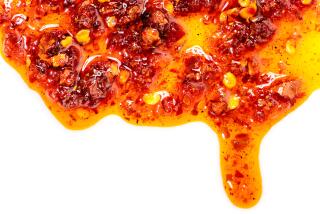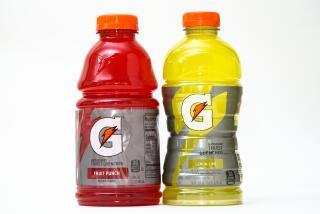Ingenuity Abounds in Marketing an Old Favorite--Ketchup
- Share via
NEW YORK — A revolution--well, perhaps that’s too strong a word--has been taking place in the ketchup business.
When you went to the grocery store in the old days, you would find the standard 14-ounce glass bottle of regular ketchup.
Now you find new-and-improved ketchups, a low-calorie version, numerous sizes and even plastic squeeze bottles.
What has happened to this 100-year-old, oh-so-American industry over the last several years?
“We’ve become more innovative recently . . . ,” says William Johnson, vice president for Heinz USA in Pittsburgh, the leading ketchup maker.
Heinz, a subsidiary of H.J. Heinz Co., has seen its ketchup sales climb in the past five years from a 44% share of the retail market to about 50%, Johnson estimates.
And 85% of those sales are in sizes or varieties that did not exist 20 years ago, he says.
Made in Fullerton
Hunt’s brand ketchup, which is made by Hunt-Wesson Foods Inc. in Fullerton, a unit of Beatrice Foods Co., has 15% of the retail market, and Del Monte, a unit of R. J. Reynolds Industries Inc., half of that, says George Novello, a food analyst with the investment firm of E. F. Hutton & Co. in New York.
“This was a stable, prosaic business in which interesting marketing has had some tremendous effects,” says Clinton Mayer, a food analyst with the investment firm of Bear, Stearns & Co. in New York.
But this type of transformation--which also affected the food service side--is not particular to the ketchup industry.
George Pierides, an analyst for Standard & Poor’s Corp. in New York, says: “Food consumption is not a terribly great growth business. What they (food companies) have to do is come out with new products and try to stimulate a segment and steal market shares from competitors. That means coming up with packaging innovations and product line extensions.”
Volume’s the Key
In the current low-inflation environment, the food companies have to spur volume because they cannot rely on price increases, Pierides adds.
The result in the ketchup business has been two-pronged. The entire industry has grown, but Heinz has benefited the most, Mayer says.
Ketchup is found in 95% of American homes, according San Francisco-based Del Monte Corp.
Americans consume the equivalent of 840 million, 14-ounce bottles a year, Del Monte says. That translates to four bottles annually for each woman, man and child.
Consumers bought $491 million worth of ketchup in 1984, down 0.4% from $493 million a year earlier, but up 32.6% from $370.4 million in 1980, according to Selling Areas Marketing Inc., a grocery business information company.
There are also numerous private labels.
Heinz’s successes have spurred competitors to reformulate their ketchup to make it “new and improved,” Mayer says.
And on the store shelves, you also see a lot more of the larger sizes.
“The more people have at home, the more they are likely to use, is the thinking,” Mayer says.
It works, says Heinz’s Johnson. “The larger sizes seem to do better proportionally over the smaller ones.”
In 1971, the company introduced its 32-ounce size, which currently represents 50% to 55% of its total bottle sales, Johnson says. A 44-ounce version was unveiled in the late 1970s, and that now represents 15% to 20% of bottle sales, he says.
Heinz is introducing a 64-ounce version of its highly successful plastic squeeze bottle, which was introduced in 1983 and has already captured 10% of Heinz’s bottle sales, Johnson says.
The squeezable bottle is lighter, so it is easier to handle and cheaper to transport. There is less waste through breakage, too.
Break With Tradition
Anthony J. F. O’Reilly, president and chief executive officer of H. J. Heinz, says: “This is a dramatic break with the traditional glass packaging, dating back to 1876, even though recent years have seen a wild proliferation ranging from individual packs in foil to bulk shipment in bags to glass containers in all sizes.”
Heinz’s low-calorie ketchup was introduced in 1979 and is available in 4% of the country. That product, which is also low in sodium, has 8 calories per tablespoon vs. 16 for the regular ketchup.
The company’s hot ketchup, which was introduced about 15 years ago, is available nationally, but only sporadically, Johnson says.
Together those two products represent only 2% of Heinz’s retail ketchup sales.
Not all innovations are major successes.
A disaster was the Mexican ketchup that Heinz tried to launch in 1981 in Denver and Dallas. That spicy variation was withdrawn within a year, Johnson says.
Behind Its Time
And take the 12-ounce, wide-mouth container that Heinz introduced in the mid-1960s.
“The wide-mouth was introduced as a way to allow people an opportunity to spoon the product out because we are perceived as so thick that it was hard to get out of the bottle,” Johnson says. “Unfortunately, it was a product behind its time and nobody really needed it.”
To back up its innovations, Heinz has stepped up its advertising considerably.
The company spent $17 million in 1984, compared to $16.1 million the previous year and $6.6 million in 1980, according to Leading National Advertisers, a business information company.
Of course, there is a price for everything, even this ketchup revolution.
Consumer prices for ketchup have increased substantially. For example, the price of Heinz’s 32-ounce bottle, the dominant size, has risen about 25% in the last five years to an average $1.35.
More to Read
Inside the business of entertainment
The Wide Shot brings you news, analysis and insights on everything from streaming wars to production — and what it all means for the future.
You may occasionally receive promotional content from the Los Angeles Times.









